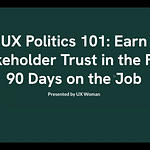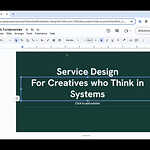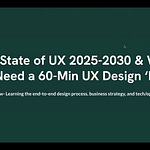Firstly, we updated our VIP UX jobs board today ($6.67/mo) with over 35+ entry level UX jobs. Some highlights include UX design, product design, UX research, and UX intern roles at Tiktok, Discord, Vonage, Visa, and Goldman Sachs. Subscribe below to get access! You can also access our free jobs board (updated, monthly).
Secondly, I would love to invite you to 8 free UX events, launching every Sunday at 4 pm ET. Come join us!
UX Politics 101: Earn Stakeholder Trust in the First 90 Days on the Job
Ghosted to Hired: UX Resumes, Portfolios, & AI Tools That Get You Interviews
Designing for Everyone: Accessibility, Inclusion & Justice in UX
UX freelance work and gig work becomes crucial in job markets where there are seasons of layoffs and mini economic downturns every few years, where hiring soars and sinks in waves, leaving us all in confusion and chaos.
I wanted to share a more personal story today of how my UX consulting work early on in my career set me up for success during one of the most economically unstable moments in my life. UX consulting in my early career gave me exposure to understanding how the design process and design methods could be applied across a variety of industries, working with brands like Ford, J&J, Chase & Meta. I was also surrounded by creatives, who coached my design sensibilities and helped me understand how design work is scoped, sold, marketed, and managed.
After I left consulting, I went to set up UX research practices for an e-commerce company, teaching senior stakeholders, designers and executives about all things UX research and why it was so important to incorporate research for all creative projects. It was my chance to scope my own projects, set my own deadlines and deliver presentations to stakeholders that left a lasting impact on the company’s UX design.
Yet something was still missing. I still couldn’t fully justify to executives about how UX design and UX research could shift the needle in terms of revenue generated, conversion rates, and higher engagement rates. I didn’t fully understand business strategy and service design when it came to defining strategies to optimize the business’s operations or scale the business. At that same time, I found out mid-job and mid-career that I had been accepted into a two-year grad program at the University of Pennsylvania, taken classes at the engineering school, design school and Wharton business school for a holistic, inter-disciplinary education on design thinking and the design process.
In a whirlwind of emotions, I committed to becoming a full-time student while still responsible for my adult duties, like paying my mortgage and living expenses. I was terrified. How was I going to survive two whole years without a full time job?
As soon as I got admitted to school, I started setting up marketing and sales outreach, DMing startup and small business clients to offer my services, honing my portfolio to showcase the breadth and depth of my design work. I hustled like I never had before, motivated to make it through my two-year program and pay all my bills. Whewsh. Adulting was really hard back then!
What did I learn from working 2-3 freelance gigs at a time while attending a full-time, two-year grad program?
If I could survive this, I could survive anything. At first the uncertainty scared me. Then I got used to it. Then I started thriving on it, creating a system for myself to stay motivated despite the fear, despite the scarcity I was feeling as I watched my savings drain from my bank account.
Not being afraid to ask for help. You never know who needs design services or UX expertise until you make them an offer. I became shameless when it came to pitching my skillsets and offering anyone and everyone help.
Real sales come from authentic connections. Sometimes these conversations were unprompted and unplanned, just genuine curiosity on my part about a person’s business or work life. When I wasn’t trying, I was the best at sales. I’d ask questions to diagnose their problems and delve into a deeper understanding of their needs and then just offer help.
And guess what? I survived two whole years of working my way through grad school. When I was laid off from my UX manager role years later, I quickly got over the sudden shock of being out of a job. That familiar fear started creeping up in me, the same old one from my grad school days, and I immediately worked to create a system for myself that could help me manage the fear, the uncertainty, the scarcity mindset with intention, being deliberate about my next moves.
And guess what? It worked out! I started investing more time into building the business I was working on, creating YouTube videos redesigning popular apps and showcasing my ideation and workshop facilitation skillsets. My manager at Disney happened to watch one of my videos and connected with me on LinkedIn. When I found out he was hiring, I DMed him about the role and he fast-tracked my application to his team. I was hired, just within a few months of being laid off.
Each professional challenge or setback has always propelled me into a new era of creativity, where the hardship catalyzed my creative juices and dared me to dream bigger and bolder.
In fact, that’s exactly what good design and good entrepreneurship is all about. Making peace with the chaos and uncertainty, forging ahead anyways, while building foundations within yourself, knowing that you can tackle almost anything that comes your way.
This is what we teach our students in our 7-Month UX Design MBA. We teach:
Navigating uncertainty within the design process via qualitative and quantitative methods.
Coming to compromises with internal teams via co-creation sessions, ideation sessions, and stakeholder interviews.
Balancing business impact with emotional storytelling when educating stakeholders on the design process, and why we do what we do.
BTW, I’m writing a book on being Delusional by Design: How UnHinged Ideas Lead To Creative Career Leaps. I talk about my personal career and provide UX challenges and case studies in the book. I’ve written about 45 pages so far and would love your feedback! If you are interested, subscribe to get access to the draft and post questions, suggestions, and comments to help me write the book in a manner that would be useful and engaging to readers like you. Let’s co-create! :D
Listen to this episode with a 7-day free trial
Subscribe to Samaya, your UX woman. to listen to this post and get 7 days of free access to the full post archives.








